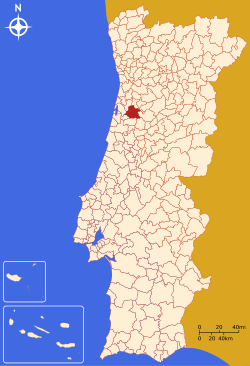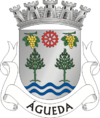Águeda
| Águeda | |||
|---|---|---|---|
| Municipality | |||

The main railroad station in Águeda
|
|||
|
|||
 |
|||
| Coordinates: 40°34′28″N 8°26′53″W / 40.57444°N 8.44806°WCoordinates: 40°34′28″N 8°26′53″W / 40.57444°N 8.44806°W | |||
| Country |
|
||
| Region | Centro | ||
| Subregion | Baixo Vouga | ||
| Intermunic. comm. | Região de Aveiro | ||
| District | Aveiro | ||
| Parishes | 11 | ||
| Government | |||
| • President | Gil Nadais Resende da Fonseca (PS) | ||
| Area | |||
| • Total | 335.27 km2 (129.45 sq mi) | ||
| Elevation | 28 m (92 ft) | ||
| Population (2011) | |||
| • Total | 47,729 | ||
| • Density | 140/km2 (370/sq mi) | ||
| Time zone | WET/WEST (UTC+0/+1) | ||
| Postal code | 3750 | ||
| Area code | 234 | ||
| Patron | Santa Eulália | ||
| Website | http://www.cm-agueda.pt | ||
Águeda (Portuguese pronunciation: [ˈaɣɨðɐ]) is a city and a municipality in Portugal. The population in 2011 was 47,729, in an area of 335.27 km². The city proper had a population of 14,504 in 2001, while the remainder is distributed in 11 parishes, within the Baixo Vouga Subregion.
Águeda, has been a municipal seat since 1834 and has had official city status since 1985. It was built on a foundation of successive Celt, Turduli and Greek inhabitants since 370 BCE.
Ancient occupation of this area was marked by diverse megalithic monuments, including the archaeological site at Cabeço de Vouga, an important Roman military fortification along routes from Olissipo (Lisbon) to Bracara.
In the 9th Century, Águeda was a prosperous burg, with stable commerce and an active port that supported local and regional businesses. It was mentioned in documents from 1050 to 1077, by its primitive name Casal Lousado (Latin: Casal Lousato), or by its anglicized forms: Anegia, Agatha and Ágada; by the 9th Century, this settlement was referred to as Ágata. In a document dated 1050, there is mention of several villages situated within the current borders, many with names originating from Arab languages.
Águeda never achieved a foral during the Middle Ages, in contrast to its neighbors, it was considered regal lands and dominions of the monasteries of Lorvão and Vacariça. It functioned as an ancillary center on the road to Santiago de Compostela, and the river-side village was most certainly visited by Queen Isabel in 1325, during her customary pilgrimages to the religious center.
A new phase of settlement occurred after the establishment of the Kingdom of Portugal, from the 11th–12th century: although its inhabitants prospered, and had many privileges, their representatives from Aveiro in the Cortes of Évora (1451), never requested a foral declaration. King D. Manuel I included Águeda in a general foral granted to Aveiro, in 1515, but was only, later, provided a separate charter.
...
Wikipedia


